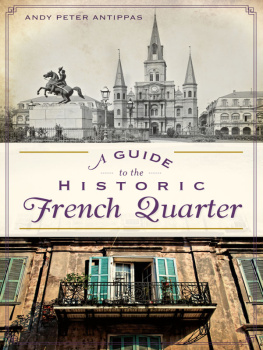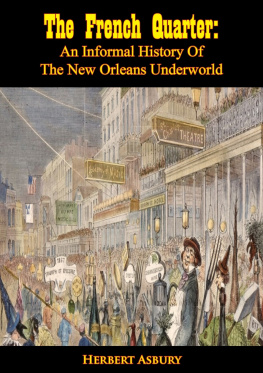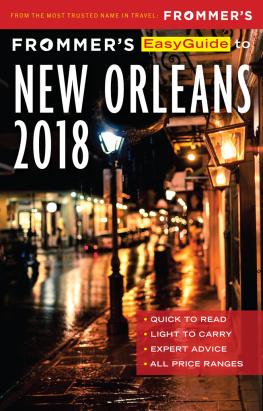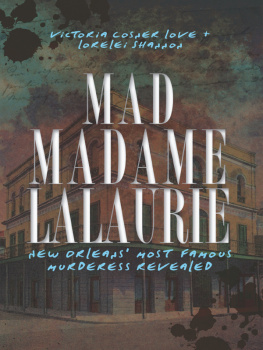


Published by The History Press
Charleston, SC 29403
www.historypress.net
Copyright 2013 by Andy Peter Antippas
All rights reserved
Front cover: Balcony. Jorge de la Torriente.
First published 2013
e-book edition 2013
ISBN 978.1.62584.764.5
Library of Congress CIP data applied for.
print edition ISBN 978.1.62619.280.5
Notice: The information in this book is true and complete to the best of our knowledge. It is offered without guarantee on the part of the author or The History Press. The author and The History Press disclaim all liability in connection with the use of this book.
All rights reserved. No part of this book may be reproduced or transmitted in any form whatsoever without prior written permission from the publisher except in the case of brief quotations embodied in critical articles and reviews.
For my wife, Tricia Moss, and her tireless assistance, and for my two daughters, Athena and Artemis, who grew up strolling through the French Quarter with me almost every Sundaypilgrimages always topped off by Swensens Bubble Gum ice cream enjoyed while sitting among the pigeons in Jackson Square.
Contents
Preface
Le Corbusiers eloquent injunction holds true for New Orleans: Towns are born, and grow throughout the ages; they deform under the assaults of life. The French Quarter has been lived in and died in; human energy has been manifested continuously and freely for 250 years. Where we find presently a sedate restaurant, we would have found20 years ago, 50 years ago, 100 years ago or morea dry goods store, a grocery, a saloon, a coffeehouse, a patisserie, an apothecary, a gambling joint, a silversmith, a printer, a jeweler, a letter-writer, a whorehouse, a bank. They may have disappeared along with their proprietors, but theyve left behind an aura that infuses the atmosphere.
It is this display of the deep and wide diversity of human lives, values and activities that is the greatness of the French Quarter and manifests itself in the range of its architectural styles, from the spectacular to the humble; its floral bouquet, from the overwhelming sweet olive behind the cathedral to the simple fern growing everywhere out of the moldering brick; in its restaurants, from the lowly shrimp po boy and muffaletta to poulet sauce Rochambeau and poisson Meunire Amandine; and in its shops, from the grandest antique shops to the scruffiest T-shirt shop.
It would take Boccaccio, Dante, Chaucer or Balzac to capture the surge of diverse humanity that has continuously lived and paraded through the French Quarter, but everyone who visits the French Quarter will experience the subtle broadening of their own sensibilitiesthat increase in compassion and generosity that comes in the confrontation with the fullness of the created world and the varicolored experience of living.
Walking through the French Quarter there is a reassuring sense of fitness, of the coherence of space, of human proportions, where nothing steals sunshine. Nothing oppresses or impinges: the simple intricacy of the streets allows everything to open freely onto everything else. There is a miraculously perfect fusion of rigidity and fluidity intimately reflecting human, cope-able life. But it is not the perfection of a Williamsburg-style restoration that is the greatness of the French Quarterindeed, it is the imminent possibility of decay that fills the French Quarter with romance.
Walking attentively through the Quarter enlarges the soul and encourages tolerance. Everything lives side-by-side in the French Quarter, the way Royal Street lives side-by-side with Bourbon Street, the way Ash Wednesday follows the debaucheries of Mardi Gras Tuesday. The French Quarter honors Saint Peter, Saint Ann and Saint Philip, and three other parallel streets commemorate Louis XIVs three bastard children, Conti, Toulouse and Dumaine. The French Quarter is un-condemning, un-embarrassed, filled with amused delight, buffoonery and the sacred, complex music of lifethere is no place more interesting to stroll through.
Acknowledgements
Indispensable for this undertaking were Francis Xavier Martins The History of Louisiana (1821, reprinted 1963), John Kendalls History of New Orleans (1922), Grace Kings History of the Creole Families of New Orleans (1921), Lyle Saxons WPA Guide to New Orleans (1938) and the Louisiana Historical Associations ongoing Dictionary of Louisiana Biography.
I am especially indebted to the charm, erudition and formidable notarial work of Stanley Clisby Arthur; the architectural and historical reference material provided in the work of Roulhac Toledano, Randolph Delehanty, Jim Fraiser and the editors of The Esplanade Ridge, New Orleans Architecture, Vol. V; the sense of place of Richard and Marina Campanella; and the Shorpies at the Shorpy Historical Photo Archive.
All the photographic material is courtesy of the Library of Congress, Prints and Photographs Division. The anonymous photographs from about 1880 to 1910 are from the LOCs Detroit Publishing Company Collection; the ones from the late 1930s are from the LOCs Carnegie Survey of the Architecture of the South archive. The Carnegie Corporation had the vision to give grants to Frances Benjamin Johnston to photograph nine southern states. Certainly, her photographs of dilapidated interiors and exteriors of structures in the French Quarter helped quicken the preservationist movement.
The map of the French Quarter is courtesy of Leslie McCormick, AIA, CNU, and Studio McCormick.
In the course of correcting the errors of others, I very likely made errors of my ownwhich I hope to correct ().
I deeply appreciate the patience, encouragement and advice of my History Press editors, Christen Thompson and Jaime Muehl.
INTRODUCTION
A History of the French Quarter
The mystery of the river the Indians called misi sipi, the ancient father of waters, remained undisclosed despite the best efforts of the Spanish explorers of the early and middle sixteenth century. Even the direction of its flow was obscured into a legend that it divided the continent of North America from east to west. It was this legend that spurred Ren-Robert Cavelier, Sieur de La Salle, to explore the prospect of finding a route to China. After thirteen years of misery and exhaustion, he trekked down to the Gulf and, in 1682, raised the standard of France on the bank of the river, claiming the vast region lying east and west for his sovereign, the Sun King, Louis XIV, and naming it Louisiana.
La Salles efforts to fortify and settle the present site of the French Quarter in 1684 and again in 1687 were futile, and it was only in 1697, when a momentary peace had come to war-ravaged France, that Count Louis de Pontchartrain, the French minister of the marine, could equip Pierre Le Moyne, Sieur dIberville, for another attempt. In 1698, Iberville sailed from Brest to Ship Island in the Gulf and, with barges laden with stores and munitions, continued up the tangled mouth of the river to the abandoned site on the crescent, where he reaffirmed Frances claim.
Ibervilles swashbuckling temperament led him to exhaust his supplies and his energies contending with the English and the Spanish settlements along the coast and trying to fortify Mobile. During his absence from the infant colony, he appointed as commander his younger brother from Montreal, Jean Baptiste Le Moyne, Sieur de Bienville. More organized and determined than his brother, Bienville successfully subdued and governed the Indians in the vicinity and settled fellow French-Canadians to test the soil and climate. When more provisions and men came in February 1718 under the financial auspices of John Laws Company of the West, the same ships carried back the announcement that the city on the crescent, between the river and the lakethe French Quarterhad been founded and named La Nouvelle-Orlans after the regent, the Duke of Orlans.
Next page













